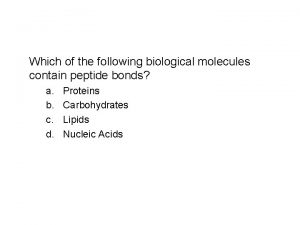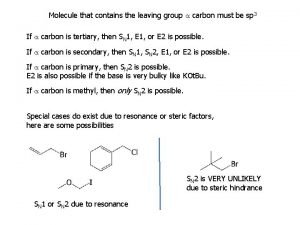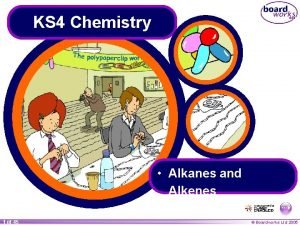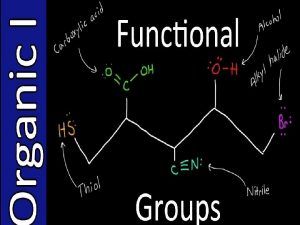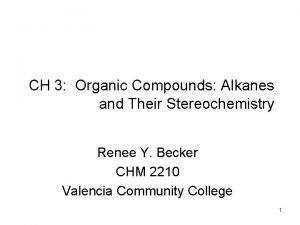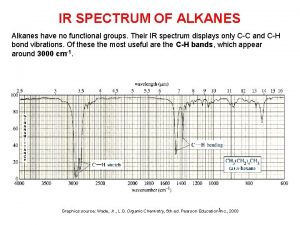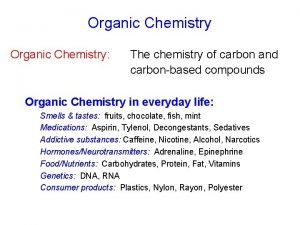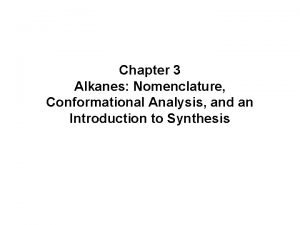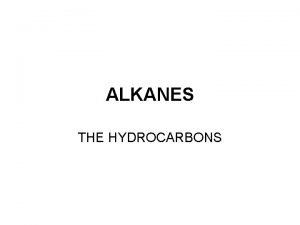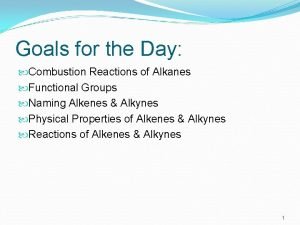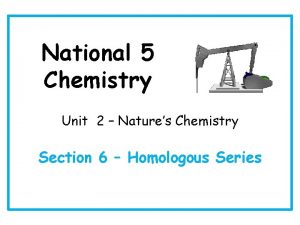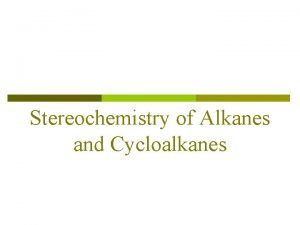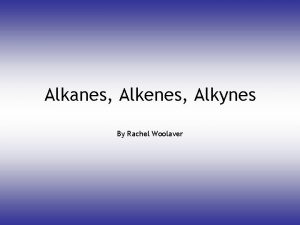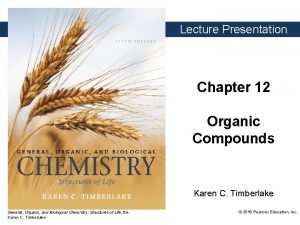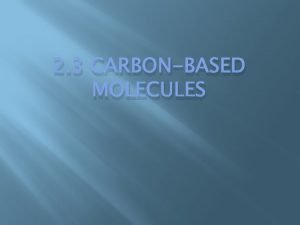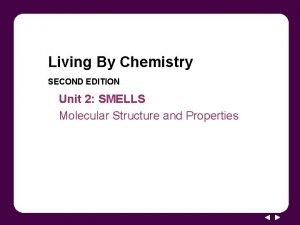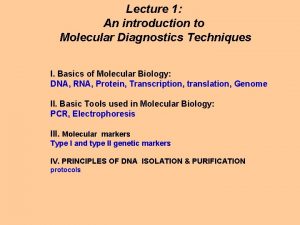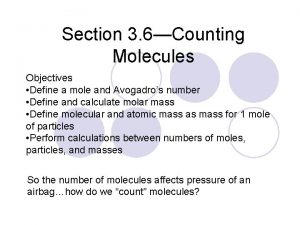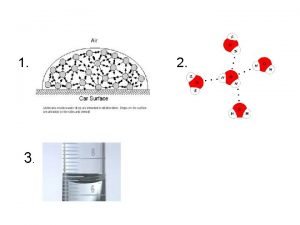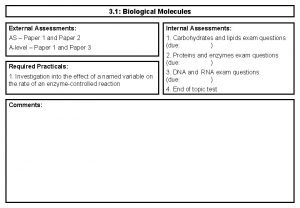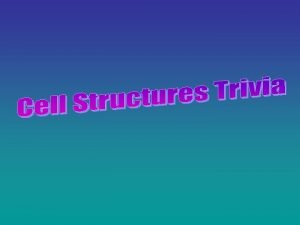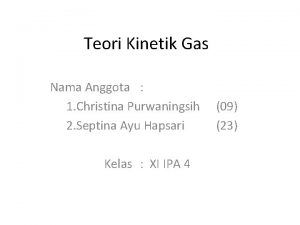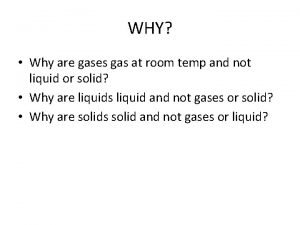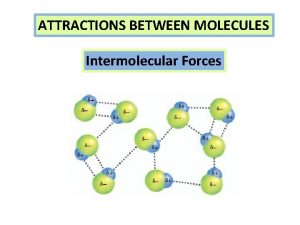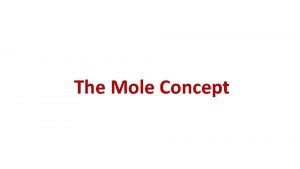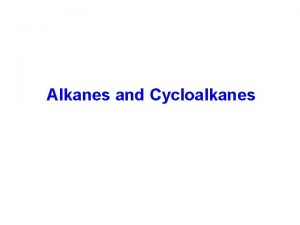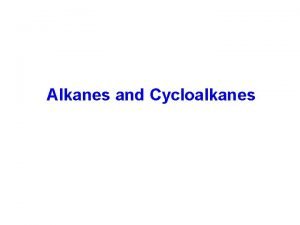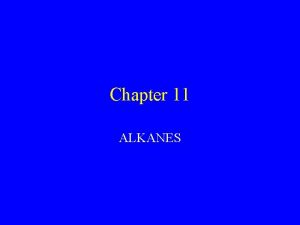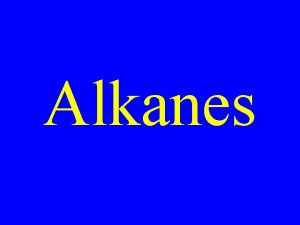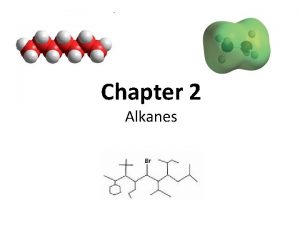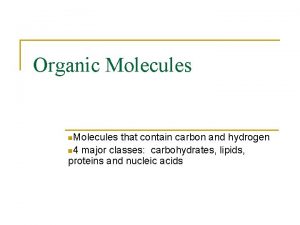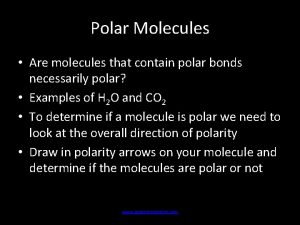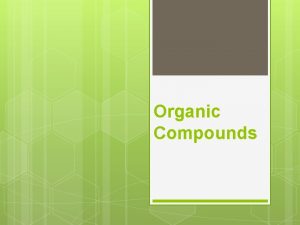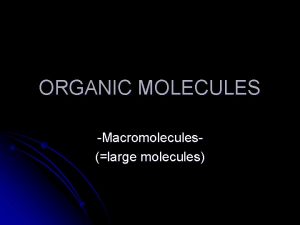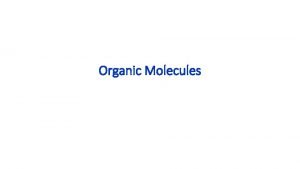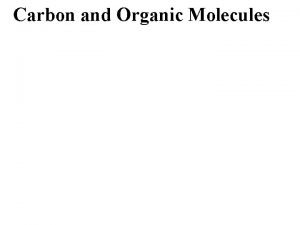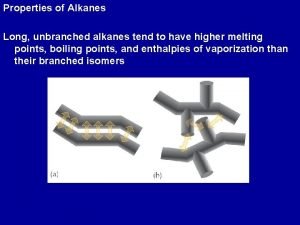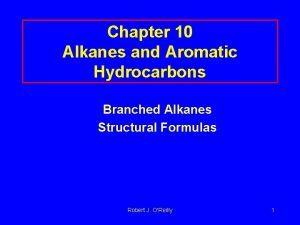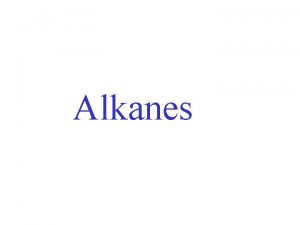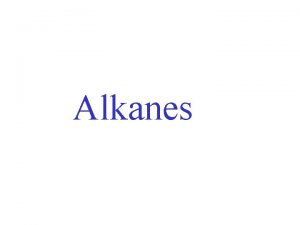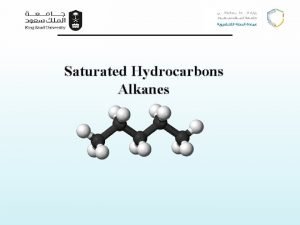Alkanes Alkanes are molecules that contain only CC





















































- Slides: 53

Alkanes

Alkanes are molecules that contain only C-C and C-H bonds. Alkanes are either acyclic or cyclic.

Acyclic alkanes (not cyclic) have the formul Cn. H 2 n+2 (where n = an integer)

Cyclic alkanes have the formula Cn. H 2 n

Practice Exercise: Circle each molecule that can be classified as an alkane

Classification of Alkanes

Straight-Chain versus Branched-Chain Alkanes

Naming Alkanes (Cn. H 2 n+2)

Before you learn to name alkanes you must…….

You must know the parent names through octane.

Naming Substituents (Alkyl Groups) Groups along C backbone are called substituents Alkane substituents are called alkyl groups Alkyl groups are the parent RH (alkane) minus a H atom

n n Alkyl group (Table 2. 3) remove one H from an alkane Name: replace -ane ending of alkane with yl ending

Common names of Alkyl groups * * Commonly used, should be memorized * * *

IUPAC Naming Alkane n IUPAC (International Union of Pure & Applied Chemistry)


Give the name of: CH 3─CH─CH 2─CH 3 STEP 1 Longest chain is butane. STEP 2 Number chain. CH 3─CH─CH─CH 3 1 2 3 4 STEP 3 Locate substituents and name. 2 -Methylbutane

Give the name of: CH 3─CH─CH─CH 3 STEP 1 Longest chain is butane. STEP 2 Number chain. STEP 3 CH 3─CH─CH─CH 3 1 2 3 4 Locate substituents and name. 2, 3 -dimethylbutane

. STEP 1: Identifying The longest Chain : (a) (b) P. 45

Identify the longest chain and then name it

STEP 2 Number the atoms in the main chain. P. 46

STEP 3 Identify and number the substituents. P. 46

P. 46

PRACTICE PROBLEM P. 47


What is the name of this alkane?

Name this compound?

Ex: Draw the skeletal structure of this compound? 3 -ethyl-2 -methylhexane

Problem: Name the following compounds?

Naming Alkane n Problem: Name the following compuonds?

Cycloalkanes n n n Cycloalkanes are alkanes that have carbon atoms that form a ring (called alicyclic compounds) Simple cycloalkanes rings of CH 2 units, (CH 2)n, or Cn. H 2 n Structure is shown as a regular polygon with the number of vertices equal to the number of C’s (a projection of the actual structure) cyclopropane cyclobutane cyclopentane cyclohexane

Naming Cycloalkanes

You must know these parent cycloalkanes (Cn. H 2 n)






Cycloalkane (Cn. H 2 n) n Ex:

Cycloalkane (Cn. H 2 n) n Ex:



PROBLEM : Name the following compounds?

PROBLEM : Name the following compounds P. 55

Types of Carbons n 4 possible carbons: Primary (1 ) carbon n Secondary (2 ) carbon n Tertiary (3 ) carbon n Quaternary (4 ) carbon n R-CH 3 R 2 -CH 2 R 3 -CH R 4 -C


Primary Through Tertiary Hydrogen Atoms

Primary Through Tertiary Hydrogen Atoms

Physical Properties of Alkanes • • • Nonpolar Insoluble in water. Lower density than water. Low boiling and melting points. Gases with 1 -4 carbon atoms. (methane, propane, butane) • Liquids with 5 -17 carbon atoms. (kerosene, diesel, and jet fuels) • Solids with 18 or more carbon atoms. (wax, paraffin, Vaseline)

Chemical reactions of Alkanes # Alkanes are unreactive as a family because of the strong C–C and C–H bonds as well as them being nonpolar compounds. 1 - Combustion (burning) Alkanes do undergo combustion in air (with oxygen O 2) which making them good fuels: • Alkanes react with oxygen. • CO 2, H 2 O, and energy are produced. • Alkane + O 2 CH 4 + 2 O 2 CO 2 + H 2 O + heat CO 2 + 2 H 2 O + energy

Chemical reactions of Alkanes 2 - Halogenation: Alkanes react with Halogens. CH 4 + Cl 2 CH 3 Cl + HCl Chloromethane CH 2 Cl 2 + HCl Dichloromethane CH 2 Cl 2+ Cl 2 CHCl 3 + HCl Trichloromethane CHCl 3+ Cl 2 CCl 4 + HCl Tetrachloromethane Heat or light (hv) CH 3 Cl+ Cl 2 Heat or light (hv)

Bromination vs Chlorination

Selectivity of bromine Bromination is slower and more selective than chlorination. n Selectivity is in the order 3 Co > 2 Co > 1 o C because Tertiary H is easier to n remove than secondary, and secondary is easier to remove than primary H 52

Question: Predict which H is easiest to abstract in each compound? Answer: Tertiary H is easier to remove than secondary, and secondary is easier to remove than primary H. 53
 Antigentest åre
Antigentest åre Organic molecules vs inorganic molecules
Organic molecules vs inorganic molecules What biological molecules contain peptide bonds
What biological molecules contain peptide bonds Leaving group chart
Leaving group chart Tôn thất thuyết là ai
Tôn thất thuyết là ai Ngoại tâm thu thất chùm đôi
Ngoại tâm thu thất chùm đôi Chiến lược kinh doanh quốc tế của walmart
Chiến lược kinh doanh quốc tế của walmart Gây tê cơ vuông thắt lưng
Gây tê cơ vuông thắt lưng Block nhĩ thất độ 2 mobitz 2
Block nhĩ thất độ 2 mobitz 2 Tìm vết của mặt phẳng
Tìm vết của mặt phẳng Sau thất bại ở hồ điển triệt
Sau thất bại ở hồ điển triệt Thơ thất ngôn tứ tuyệt đường luật
Thơ thất ngôn tứ tuyệt đường luật Hãy nói thật ít để làm được nhiều
Hãy nói thật ít để làm được nhiều Thơ thất ngôn tứ tuyệt đường luật
Thơ thất ngôn tứ tuyệt đường luật Myth eth prop
Myth eth prop Hydrocarbons contain only _____.
Hydrocarbons contain only _____. Uses of alkanes
Uses of alkanes Test for alkenes
Test for alkenes Alkanes are also called
Alkanes are also called Alkanes solubility
Alkanes solubility Relative stability of isomeric alkanes
Relative stability of isomeric alkanes Alkanes def
Alkanes def Alkanes list
Alkanes list Iupac practice sheet
Iupac practice sheet Terminal alkyne ir spectrum
Terminal alkyne ir spectrum Halogenation of alkanes mechanism
Halogenation of alkanes mechanism Alkylation of alkanes
Alkylation of alkanes Sources of alkanes
Sources of alkanes General formula for alkyl group
General formula for alkyl group But pent hex hept
But pent hex hept Combustion reaction of alkanes
Combustion reaction of alkanes Uses of alkanes
Uses of alkanes Alkane viscosity
Alkane viscosity Gauche conformation
Gauche conformation Alkanes alkenes alkynes
Alkanes alkenes alkynes Chemisty
Chemisty Complete combustion of octane
Complete combustion of octane Leave only footprints take only photos
Leave only footprints take only photos Mole number
Mole number Atoms ions and molecules
Atoms ions and molecules Picometer symbol
Picometer symbol Carbonbased molecules found in
Carbonbased molecules found in Honc 1234
Honc 1234 Molecules biology definition
Molecules biology definition How to convert moles to molecules
How to convert moles to molecules Hydrophilic molecules
Hydrophilic molecules Biological molecules exam questions
Biological molecules exam questions Preparation of protein molecules for cellular exportation
Preparation of protein molecules for cellular exportation Sebuah tabung yang volumenya 1 liter mempunyai lubang
Sebuah tabung yang volumenya 1 liter mempunyai lubang Interacting molecules or ions
Interacting molecules or ions Intermolecular forces and boiling point
Intermolecular forces and boiling point How are atomic and molecular orbitals related
How are atomic and molecular orbitals related Avagadro number symbol
Avagadro number symbol Cold molecules
Cold molecules


